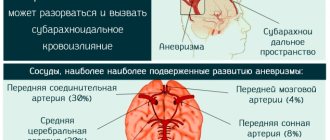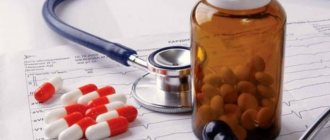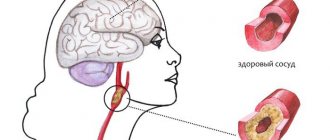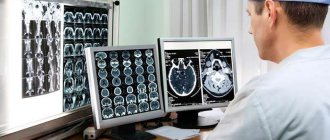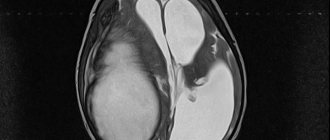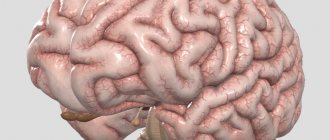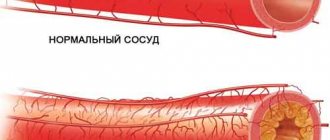Symptoms
Among the symptoms of cerebral atherosclerosis are:
- Certain signs of cerebral atherosclerosis include the following symptomatic picture:
- Sleep problems: insomnia, disturbing dreams, difficulty getting up and problems falling asleep again;
- Loss of sensation in half of the body;
- Severe, frequently recurring headaches;
- Increased cholesterol levels in blood tests:
- Changes in gait and loss of coordination;
- Changes in vision, flickering of “spots” before the eyes, tinnitus;
- Emotional changes: irritability, depression, tearfulness and anxiety;
- Hot flashes and sweating of the face;
- Increased fatigue, constant weakness and absent-mindedness;
- Trembling of the chin and limbs;
- Memory impairment, problems with short-term memory;
- The appearance of facial asymmetry. Source: L.S. Bizhanova. Ischemic brain disease // Bulletin of KazNMU, No. 2, 2015, pp. 241-242 Shabir O.
Clinical signs do not appear immediately. This happens long after cholesterol has begun to be deposited. Symptoms appear after the lumen of the arteries and capillaries of the brain narrows so much that 15% or more less blood begins to flow to the organs.
Signs of the disease depend on the stage:
1. In the first stages, the disease makes itself felt only after physical or emotional stress and quickly passes when the patient goes into a state of rest. The main symptom is asthenia, accompanied by fatigue, weakness, decreased alertness, and general lethargy. Rarely, sleep is disturbed, insomnia or daytime sleepiness occurs. Mostly, patients complain of headaches, tinnitus, and memory impairment. In the latter case, patients remember the past well, but do not remember new information well.
2. As the disease progresses, anxiety, suspiciousness, depression, and mood swings appear. Memory impairments become more pronounced, to the point that the patient does not remember what happened to him today. There is a constant headache and noise in the ears, speech is persistently impaired - it becomes unclear, diction changes, patients feel dizzy and have unsteady gait. Hearing and vision also deteriorate, limbs and head shake, and a person stops thinking logically and clearly.
3. At the last stage of atherosclerosis, dementia develops; the patient may behave like a child or become aggressive and tearful. Most people completely or partially lose their memory and cease to be interested in the world around them and the events in it. The ability to navigate in time and space is lost, the patient needs constant care because he loses self-care skills in everyday life. This stage is irreversible.
Diagnostic criteria
Atherosclerosis of the cerebral arteries is a disease whose initial signs can be difficult to detect. It is important to promptly contact a specialist in the field of cardiology, angiosurgery and neurology.
The first thing you need to do is visit a therapist. He, taking into account the need, will write out referrals to other, more specialized specialists. The main treatment is usually carried out by a cardiologist and a neurologist, with other doctors helping in the process. To make a diagnosis, you need to conduct a series of examinations.
To clarify it, the specialist prescribes the following procedures:
- lipid profile;
- ultrasonography;
- x-ray of blood vessels;
- magnetic resonance imaging of the brain;
- Dopplerography of blood vessels;
- electroencephalogram;
- immunological blood test.
A competent approach to diagnosis will help to quickly detect an already developed form of cerebral atherosclerosis and select the appropriate treatment option.
Diagnostics
A neurologist deals with this disease. First, the doctor collects anamnesis, interviews the patient about complaints, and conducts a series of tests. So, the following factors indicate the presence of the disease:
- The patient cannot look up;
- Reflexes are weakened or excessively increased, most often asymmetrically;
- In a standing position, legs together, arms extended forward, the patient cannot maintain balance;
- When the patient stretches his arms forward, his fingers tremble and become weak;
- Closing his eyes, a person cannot bring his finger to the tip of his nose.
These are indirect signs that only allow us to make an assumption about the presence of atherosclerosis. Therefore, a comprehensive examination is then carried out with consultations of other doctors - ENT, ophthalmologist, etc., depending on the existing disorders. At the medical office, you can get advice from related specialists on any disease, including in cases of suspected cerebral atherosclerosis. Source: Berwick J, Francis SE. Neurovascular dysfunction in vascular dementia, Alzheimer's and atherosclerosis // BMC Neurosci. 2021 Oct 17;19(1):62. doi:10.1186/s12868-018-0465-5.
In addition, it is necessary to undergo a biochemical analysis of the blood lipid spectrum (cholesterol, triglycerides, etc.)
List of instrumental studies:
- REG – radioencephalogram;
- Angiography of cerebral vessels;
- Duplex head scanning;
- Ultrasound Dopplerography of cerebral vessels;
- MRI of cerebral vessels;
- CT – computed tomography;
- EEG – electroencephalogram.
The diagnostic capabilities of a medical doctor allow you to accurately diagnose atherosclerosis, the extent of the disease and choose an effective treatment regimen.
Causes of the disease
Experts have identified many causes of cerebral atherosclerosis, which in most cases are combined with each other. The main and most common phenomenon that leads to the deposition of cholesterol plaques in the blood vessels of the brain is age. After 50 years, this disease occurs to one degree or another in 8 out of 10 people. The reasons for this are not fully understood, but scientists are inclined to believe that the body’s inability to remove harmful lipids from the body is caused by a natural slowdown in metabolism and changes in hormonal levels.
In addition, the risk of atherosclerosis at a young age can be affected by:
- unbalanced diet with a predominance of fatty, fried foods rich in carbohydrates and fats, hot spices in the menu against the background of an insufficient amount of fresh vegetables and fruits;
- irregular eating, when periods of acute hunger alternate with eating excessive amounts of food;
- diseases associated with metabolic disorders - diabetes, obesity, hypo- and hyperthyroidism and others;
- physical inactivity or lack of physical activity and resulting obesity;
- bad habits - smoking and alcoholism, which provoke vasoconstriction and affect the circulatory system as a whole.
Doctors do not rule out the influence of a genetic factor. According to statistics, 9 out of 10 people suffering from cerebral atherosclerosis have immediate relatives who also encountered diseases caused by the deposition of cholesterol in the circulatory system.
Since atherosclerosis very often occurs against the background of hypertension, experts classify this disease as a provoking one. Since stress is the main cause of high blood pressure, it is also considered indirectly involved in the occurrence of pathology. Under the influence of psycho-emotional factors, blood vessels can change their tone several times during the day (contract and relax), as a result of which microdamages form on their inner surface. On such wounds, cholesterol settles quite quickly, forming plaques.
Despite identifying the main sources of the disease, doctors cannot identify the main cause of cerebral atherosclerosis. They call this disease polyetiological, that is, developing as a result of a combination of several factors.
Treating atherosclerosis
- Shishkin A.A.
- Volkov A.M.
- Kabirov A.V.
- Baranov V.S.
Shishkin Andrey Andreevich
Candidate of Medical Sciences. Surgeon, proctologist, phlebologist at SM-Clinic. Proficient in all modern methods of conservative and surgical treatment of diseases of the veins of the lower extremities (including sclerotherapy, EVLT - endovasal laser coagulation, traditional phlebectomy)
Read moreVolkov Anton Maksimovich
Phlebologist, surgeon at SM-Clinic. Performs operations with a modern proprietary method of treating varicose veins using a laser (modified endovenous laser coagulation. M-EVLC).
Surgical treatment of varicose veins of any complexity (phlebectomy, miniphlebectomy) More detailsKabirov Alexander Vitalievich
Cardiovascular surgeon at SM-Clinic. Candidate of Medical Sciences Proficient in all modern methods of conservative and surgical treatment of diseases of the veins of the lower extremities (including sclerotherapy, EVLT - endovasal laser coagulation, traditional phlebectomy)
More detailsBaranov Vladimir Sergeevich
Cardiovascular surgeon at SM-Clinic. Candidate of Medical Sciences Treats lower varicose veins using non-surgical and surgical methods (aesthetic sclerotherapy, ECHO sclerotherapy, stem sclerotherapy, phlebectomy, miniphlebectomy, EVLT).
More details
Treatment
The basis of treatment for this pathology is lifestyle adjustments. This means:
- lipid-restricted diet,
- rejection of bad habits,
- physical activity regimen,
- avoiding stress,
- treatment of chronic diseases.
The focus of drug therapy is the use of lipid-lowering drugs, antiplatelet, antihypertensive and antioxidant drugs, drugs to improve microcirculation and symptomatic therapy. Therapy, as a rule, takes a very long time and depends on the stage at which it was started.
In case of severe stenotic processes, surgical treatment is recommended for the patient. Most often, surgical intervention is performed on the internal carotid arteries. Source: E.A. Shirokov. Stenosing atherosclerosis of the cerebral arteries: modern strategies for diagnosing and treating patients // Consilium Medicum, vol. 18, no. 9, 2021, pp. 37-42.
Treatment for this disease is aimed at ensuring that metabolic processes are restored, and harmful cholesterol no longer settles on the walls of blood vessels. At the same time, attention is also paid to restoring blood circulation and normalizing the nutrition of brain tissue.
Drug therapy
This is the most important part of the comprehensive treatment of atherosclerosis. Patients may be prescribed several groups of medications:
- Statitis - reduce the size of cholesterol plaques, reduce the risk of narrowing of the main arteries of the brain, and stop the growth of plaques.
- Antiplatelet agents – reduce blood viscosity and prevent blood clots.
- Fibrates are similar in action to statins, but do not affect the size of plaques, but lower the triglyceride content in the blood.
- Means for restoring vascular function.
- Bile acid sequestrants prevent cholesterol from being absorbed from food.
- Nootropics and medications that improve metabolic processes in nervous tissue.
- Hypotensives that stabilize blood pressure and help prevent stroke.
- Vitamins and minerals are complex to improve the general condition of the body. They must contain vitamins A, C, group B and nicotinic acid.
Medicines are taken in long courses, and most of them are taken for life with periodic dosage adjustments.
Surgical treatment
Operation is a last resort, indications for it:
- narrowing of the lumen of the carotid artery by 70% or more;
- condition after a minor stroke;
- recurrent ischemic attacks.
Surgical options:
- bypass - the formation of a vessel bypassing the one affected by cholesterol deposits;
- endarterectomy - a procedure to remove cholesterol plaques along with a small amount of tissue that lines the vessel from the inside;
- stenting using endoscopic technology - an expanding structure impregnated with a composition that dissolves cholesterol is installed in the vessel.
Operations can be performed under general anesthesia or local anesthesia. An anesthesiologist is consulted before the operation. The length of hospital stay varies depending on the technique, as do recommendations for the recovery period. SM-Clinic doctors inform patients in detail about all the nuances and are ready to answer any questions related to treatment at the initial consultation. Consultation on the operation is free of charge.
You can find out more about discounts on preoperative examinations by following the link.
Pathogenesis
The causes of the onset and development of the disease include multiple factors. These include:
- disruption of lipid (fat) metabolism;
- excess cholesterol in the blood (this condition has its own reasons);
- slow elimination of cholesterol;
- persistent increase in blood pressure for a long time;
- genetic predisposition;
- increased blood viscosity;
- diabetes mellitus (therapy is carried out by an endocrinologist);
- weakness of the vascular wall;
- general condition of the body;
- diseases of unspecified genesis (origin).
The group of those at risk of cerebral atherosclerosis includes:
- smoking and alcohol abusers;
- obese;
- leading a sedentary lifestyle;
- having frequent or prolonged experiences, stress. (Consultation with a psychologist will help to cope with the problem)
Diet
Changing your diet is also a way to improve your well-being and is a great help for other treatment methods. Atherosclerosis very often progresses precisely against the background of poor nutrition and lifestyle, so it is necessary
- follow a certain diet:
- reduce consumption of red and fatty meats and meat in general;
- limit the consumption of confectionery products and baked goods;
- eat as few egg yolks as possible;
- limit solid vegetable fats – margarine – in the diet;
- completely eliminate alcohol, sausages, fast food, and canned food.
Recommended products include vegetables (fresh, pickled, dried), cereals (rice, buckwheat, barley, millet, oats, flax, etc.), dried, fresh and dried fruits, turkey and chicken fillets, river and sea fish.
You need to eat at least 5 times a day at the same time in small portions. It is necessary to avoid fried foods and prepare food using the methods of boiling, steaming, stewing, and baking.
Types of cerebrosclerosis
Before considering the question of how to get rid of the disease, you should familiarize yourself with the classification. The following types of cerebral atherosclerosis are distinguished:
- Intermittent (development has a wave-like character, deterioration is replaced by improvement and vice versa);
- Slowly progressive (the clinical picture gradually worsens);
- Malignant (acute) is characterized by the diagnosis of sclerosis at the stage of irreversible changes, and can also manifest as a stroke or mental disorder.
Important! The most unfavorable type of disease development is type 3. What is dangerous about the acute form is the rapidly developing irreversible consequences leading to death. Such manifestations as memory loss, frequent ischemic attacks, and stroke come to the fore.
In addition to the speed of development, the location of the affected artery is also taken into account when making a diagnosis:
- posterior brain;
- sleepy (internal or general);
- brachiocephalic trunk;
- vascular network of the brain.
The larger the diameter of the affected vessel, the more pronounced the pathology. Changes in small vessels have little effect on the general condition of the patient and have more sparse symptoms.
Possible risks associated with atherosclerosis
The most dangerous complication is a stroke. If at the same time the patient has poor eating habits, is overweight, moves little and is regularly exposed to stress, then with an 80% probability he will become disabled as a result, unable to care for himself. The mortality rate is also high.
Prevention
To prevent cerebral atherosclerosis, you need to avoid smoking, follow a diet, and keep yourself in good shape with moderate physical activity. It is very important to establish a psycho-emotional background, protect yourself from stress, and if this is not possible, then take courses of sedatives and amino acids, for example Glycine.
What happens in the vessels?
As a result of a failure in lipid (fat) metabolism in the body, cholesterol begins to be deposited on the vascular wall, gradually increasing and forming atherosclerotic or lipid plaques. Over time, they become larger and clog the channel, slowing down the normal flow of blood, and with it delaying the supply of oxygen to all parts of the brain.
Next, loose and then dense blood clots form in the vessels of the brain tissue, which accumulate near the nodes where the lateral branches depart from the arteries and in the cerebral cortex.
The main and middle arteries are at risk of overgrowing with thrombotic plaques. Thrombosis results in cysts, scars, and areas of dead cells (necrosis).
When nerve cells suffering from a lack of oxygen are destroyed, mental activity is disrupted.

